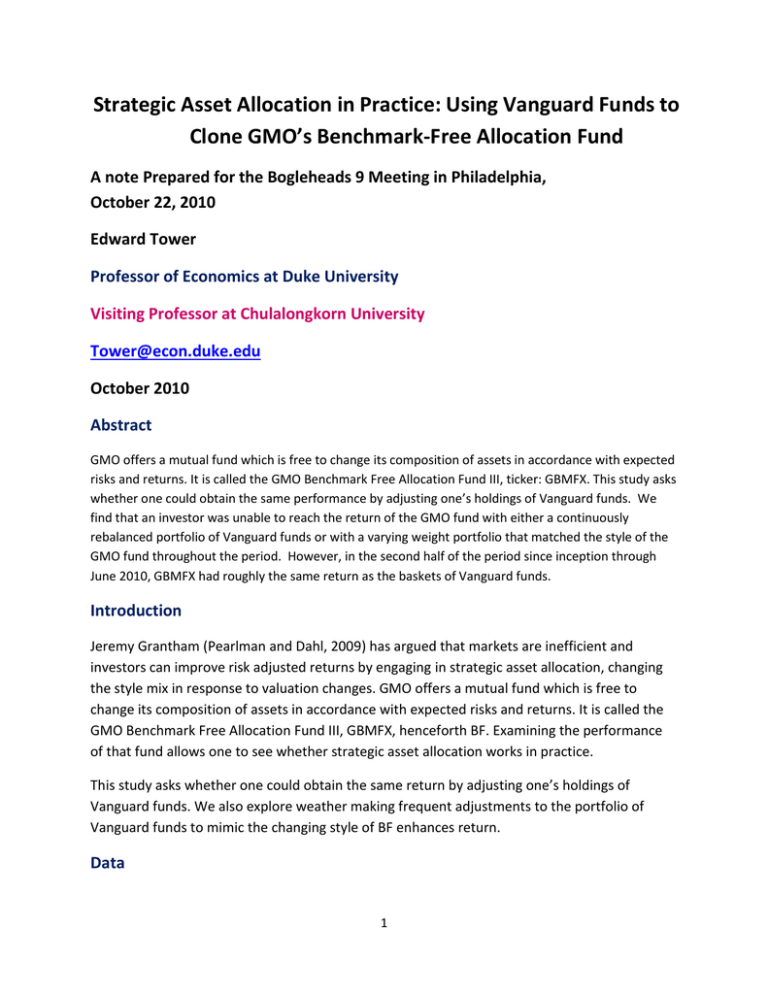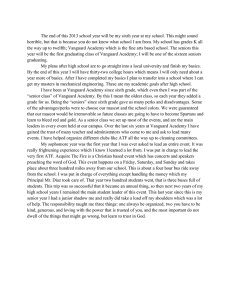does not - during menopause has been such
advertisement

Strategic Asset Allocation in Practice: Using Vanguard Funds to Clone GMO’s Benchmark-Free Allocation Fund A note Prepared for the Bogleheads 9 Meeting in Philadelphia, October 22, 2010 Edward Tower Professor of Economics at Duke University Visiting Professor at Chulalongkorn University Tower@econ.duke.edu October 2010 Abstract GMO offers a mutual fund which is free to change its composition of assets in accordance with expected risks and returns. It is called the GMO Benchmark Free Allocation Fund III, ticker: GBMFX. This study asks whether one could obtain the same performance by adjusting one’s holdings of Vanguard funds. We find that an investor was unable to reach the return of the GMO fund with either a continuously rebalanced portfolio of Vanguard funds or with a varying weight portfolio that matched the style of the GMO fund throughout the period. However, in the second half of the period since inception through June 2010, GBMFX had roughly the same return as the baskets of Vanguard funds. Introduction Jeremy Grantham (Pearlman and Dahl, 2009) has argued that markets are inefficient and investors can improve risk adjusted returns by engaging in strategic asset allocation, changing the style mix in response to valuation changes. GMO offers a mutual fund which is free to change its composition of assets in accordance with expected risks and returns. It is called the GMO Benchmark Free Allocation Fund III, GBMFX, henceforth BF. Examining the performance of that fund allows one to see whether strategic asset allocation works in practice. This study asks whether one could obtain the same return by adjusting one’s holdings of Vanguard funds. We also explore weather making frequent adjustments to the portfolio of Vanguard funds to mimic the changing style of BF enhances return. Data 1 BF was established 23 July 2003. I compare its performance with a basket of Vanguard funds. The collection of Vanguard funds used for the comparison is indicated in the top row of Figure 1. I used the following Vanguard funds. Dividend growth, VDIGX, a clone of GMO’s Quality fund,1 Total stock market index, VTSMX, to provide exposure to the whole US stock market, Value index,VIVAX, to permit the portfolio to be tilted to value, Small company, NAESX, to permit the portfolio to be tilted to small, Developed market index, VDMIX, to capture the returns of international developed markets, Emerging markets index, VEIEX, to capture the returns of emerging markets, Total bond market index fund, VBMIX, to capture the return of the whole US bond market, Short term bond index, VBISX, to capture the return of short maturity bonds, Inflation protected securities, VIPSX, to capture the return of inflation protected bonds. The data is daily returns provided by The Center for Research in Security Prices, CRSP, downloaded from the CRSP web site. I use data from August 1, 2003 through June 30, 2010. The constant asset allocation comparison I compare the return of BF, with that of a basket of Vanguard funds rebalanced daily. The basket is determined as that collection of Vanguard funds with constant portfolio weights, that most closely tracks BF. We call this the tracking portfolio. I look for the portfolio of Vanguard funds, such that the daily return of BF minus that of the portfolio has the smallest standard deviation. I label that the tracking portfolio. 1 GMO on its web page has been recently been predicting high returns from investing in quality stocks. Thus it seemed likely that GBMFX would invest in part in assets which are held in the GQETX portfolio. VDIGX is the Vanguard mutual fund whose returns best explain GQETX, using Sharpe’s method of style analysis. Thus, it seemed likely that one component of the return of GBMFX would be explained by that of VDIGX. 2 To perform this task, I regress the daily return of BF on the daily returns of the Vanguard funds plus a constant term, while constraining all of the coefficients of the index funds to be non-negative and to sum to one. The result is: (2) RBF = [a constant term] + 0.0 RVTSMX +0.14 R VDIGX + 0.0 R ViVAX + 0.01 R NAESX +0.04 R VDMIX + 0.14 R VEIEX + 0.0 RVBMFX 0.62 R VBISX + 0.05 R VIPSX. where R denotes monthly (real) return in percentage points per year. These coefficients are reproduced in the top line of Exhibit 2. This regression says that BF is an asset whose return is best described as the return of a basket of index funds consisting of 14% invested in the VDIGX fund, 1% in NAESX, 4% in VDMIX, 14% in VEIEX, 62% in VBMFX, and 5% in VIPSX, with an additional return equal to the constant term, and a random term, where the index basket is rebalanced at the beginning of each dauy. This basket is defined as the tracking portfolio. Here BF outreturns the tracking index by the constant term. This composition of the tracking index is recorded in Exhibit 2. This method of style analysis was developed by Sharpe (1992) and is explained there and by Bodie, Kane and Marcus (2008, pp.875-879). Sharpe writes (1992, p.13) “. . . style analysis provides measures that reflect how returns act, rather than a simplistic concept of what the portfolios include.” His paper is online, clear, displays helpful graphs and is easy to read. The software used to perform this calculation is Microsoft Excel’s Solver. 3 The red line in Exhibit 1 shows the cumulative value of investing one dollar in BF, and continually reinvesting any proceeds, divided by the same for the tracking portfolio of Vanguard funds. Thus it is the ratio of BF value to Vanguard value. When it is upward sloping BF outperforms the Vanguard tracking portfolio. Over the period BF outperforms by 4.6% per year. However, from mid-2006 until mid-2010, the cumulative return of BF and the Vanguard index are identical. Thus, over the entire period GMO’s benchmark free allocation fund outreturns the constant-weight Vanguard portfolio by 4.6%/year, but the excess return is the consequence of the returns in the early half of the period. Strategic Asset Allocation Comparisons The brown line shows the same when we divide the period into two halves and use the first half tracking index for the Vanguard comparison in the first half of the period and the second half tracking index for the Vanguard comparison in the second half of the period. We are permitting strategic asset allocation for the Vanguard funds to mimic the BF allocation. We discover that the BF excess return is now only 2.5%/year. Again, the advantage of BF is all due to its outperformance before the middle of 2006. Orange, purple and black show more frequent strategic asset reallocation: the period divided into quarters, years and months. The outperformance of BF is 2%/year, 1.3%/year and 1% per year, respectively. Again, all of the outperformance is prior to the middle of 2006, except for the period divided into quarters. The overall conclusion is that the more frequently the Vanguard basket is adjusted to mimic the allocation of BF, the lower is the advantage of BF. We conclude, there is advantage from strategic asset allocation as practiced by BF. BF dramatically 4 out-returns its whole period Vanguard tracking portfolio (4.6%/year), but out-returns the more frequently adjusted tracking portfolio by much less (1%/year). How much adjustment is there in BF’s tracking basket? The high of the S&P 500 index since the inception of BF occurred on October 9, 2007, and a low on March 5, 2009. The right hand side of Exhibit 2 presents GMO’s predicted asset real returns over the next 7 years for US stocks, foreign stocks, and bonds. These are averaged over US large and small stocks; foreign large company, foreign small company, and emerging markets; and intermediate term government bonds, short term government bonds and inflation protected treasuries. They are presented as averages for the entire period during which BF existed (top line) and for the beginning of the quarter closest to the market high and low (second and third lines). The predicted returns for US stocks and foreign stocks and the predicted return differentials relative to the bond average are highest for the market low, next highest for the average over the period and lowest for the market high. If BF allocated funds in accordance with the predictions, we would expect the bond share to be lowest at the market low and highest at the market high. In fact the bond share is 51% at the market low and 65% at the market high. At the market high the differential expected return differential favoring foreign stocks is lowest and at the market low it is highest. We would expect the ratio of stock holdings to reflect this. In fact the ratio of foreign to US stock holdings follows the opposite pattern. Thus it appears that BF does not allocate assets in accordance with GMO’s predictions. Conclusion 5 GMO’s Benchmark Free Allocation Fund III, BF, since its inception has returned more than the comparable constant-weight corresponding Vanguard portfolio (4.6%year). When the Vanguard portfolio is strategically adjusted each month so as to reflect the style composition of BF, BF’s excess return falls dramatically (to 1%/year). Thus we can attribute 3.6%/year excess return to strategic asset allocation. However, all of the excess return in all cases save one is attributed to the excess return prior to mid 2006, and in the one remaining case, that is true of the bulk of the excess return. We also discover that the asset composition of BF does not reflect the 7 year asset class predicted returns on the GMO web page. My first take away from this is that the gains from strategic asset allocation as exhibited by GMO are substantial, but they are not consistent. My second take away is that GMO does not use its 7 year asset class return predictions to guide the asset allocation of its Benchmark Free Asset Allocation Fund III. References Bodie Z., A. Kane, and A. J. Marcus. 2008. Essentials of Investments. New York: McGraw Hill. GMO web page. 2010. http://www.gmo.com/America/MyHome/default Pearlman, Russell and Jonathan Dahl, “Why Jeremy Grantham Changed His Mind,” Smart Money, May 21, 2009. http://www.smartmoney.com/Investing/Economy/Why-JeremyGrantham-Changed-his-Mind/ Sharpe, W. F. 1992: Asset Allocation: Management Style and Performance Measurement, Journal of Portfolio Management 18:2 (Winter), 7-19. Tower, Edward. 2010a. “GMO versus Vanguard: Who Selects Stocks Better? 6 Tower, Edward. 2010b. GMO’s Predictions as Pilots for Vanguard Portfolios: Are They a Useful Guide for Strategic Asset Allocation? Duke University “Working Paper, October. Exhibit 1. Cumulative value of GMO Benchmark Free Allocation relative to its tracking index of Vanguard funds 1.5 1.45 1.4 1.35 1.3 1.25 1.2 1.15 1.1 1.05 1 2003.5 2004.5 2005.5 2006.5 2007.5 Whole period tracking index 4.6%/yr quarter period (1.75 year) 2.0%/yr 20 day (roughly 1 month) 1.0%/yr 7 2008.5 2009.5 2010.5 Half period (3.5 year) 2.5%/yr 250 day (roughly 1 year) 1.3%/yr Exhibit 2. Composition of tracking index for GMO benchmark free allocation total Emer-III. Inflation fund stock divismall develpd ging short share of market dend value co market Market Total term vanguard fund in index growth index index index Index bond bond tracking index VTSMX VDIGX VIVAX NAESX VDMIX VEIEX VBMFX VBISX protectd securUS foreign ities stock stock bonds VIPSX total total total Total portfolio whole period 0 14 0 1 4 14 0 62 5 15 18 67 100 stock market high 9 October 2007 22 13 3 2 0 9 0 26 26 40 9 51 100 stock market low 5 March 2009 0 29 0 0 0 5 51 14 0 29 5 65 100 8 Average predicted returns US -0.45, Foreign 4.37, bonds 1.74 US -1.35, foreign -0.2, bonds 1.07 US 4.45, foreign 7.07, bonds 1.07







